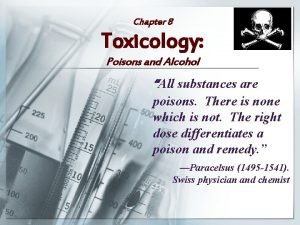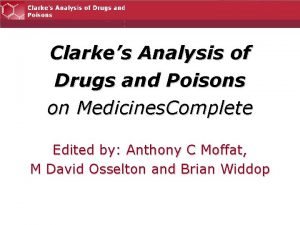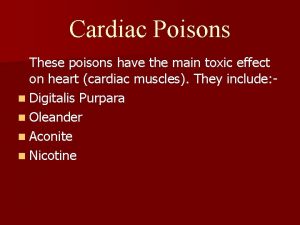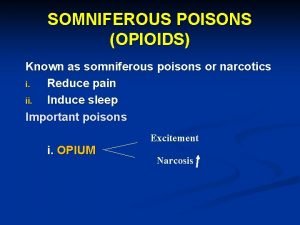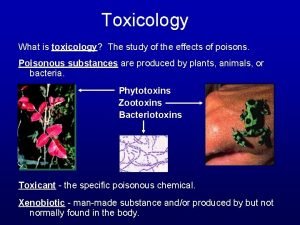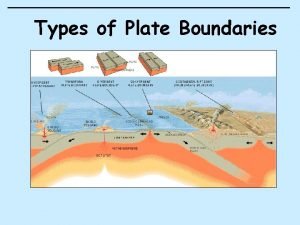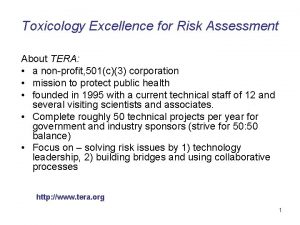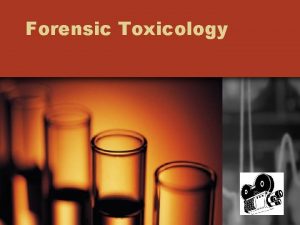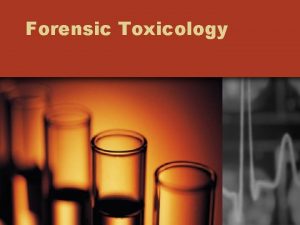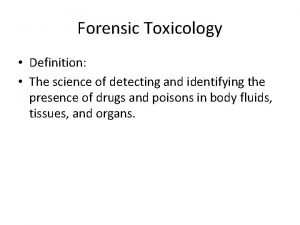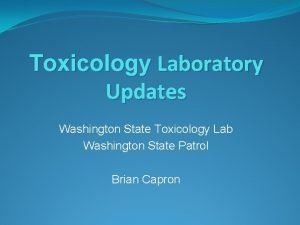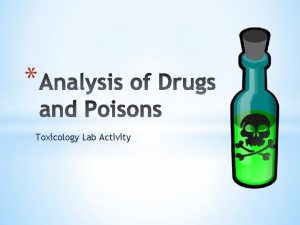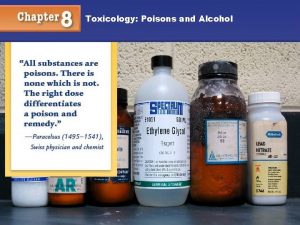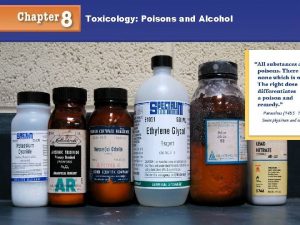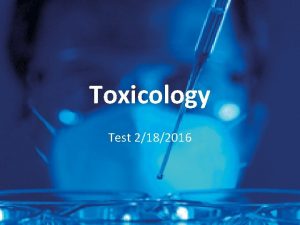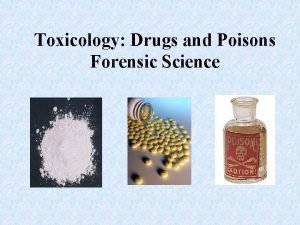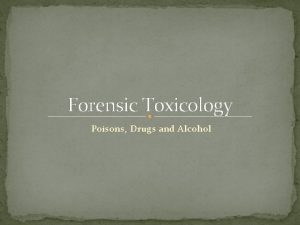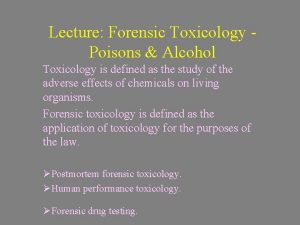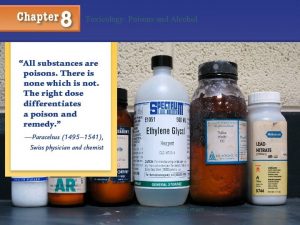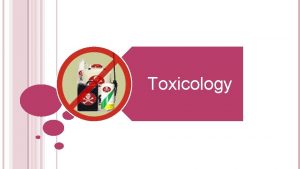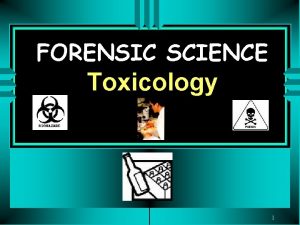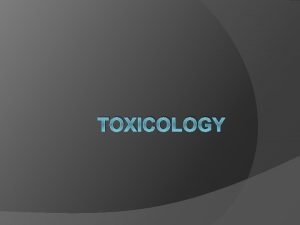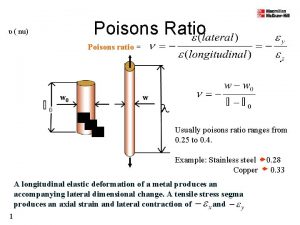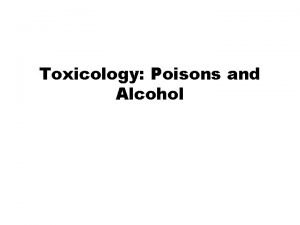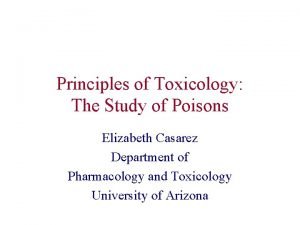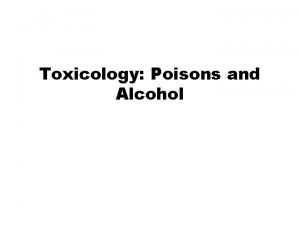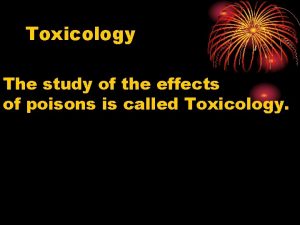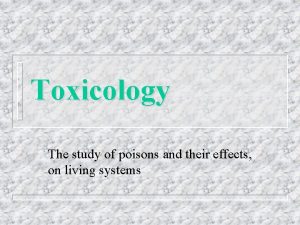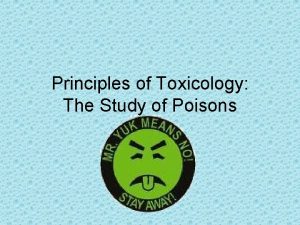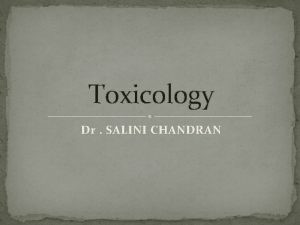Toxicology Toxicology Study of poisons There are four































- Slides: 31

Toxicology

Toxicology Study of poisons. There are four major disciplines: 1. Mechanistic: elucidate the cellular and 2 biochemical effects of toxins. 2. Descriptive: uses results of animal experiments to predict harmful effects to humans. 3. Forensic: concerned with medicolegal consequences of exposure to a toxin. 4. Clinical: the study of interrelationships between toxin exposure and disease states (diagnosis & therapeutic intervention)

Exposure to Toxins Occurs by various routes: Suicide (50%) Accidental (30%) Rest are related to: occupational exposure or homicide 3

Routes of Exposure Toxins enter the body by several routes: 1. Ingestion most often seen in a clinical setting to exert a systemic effect, they must be absorbed into circulation most are absorbed by passive diffusion If not absorbed they may produce local effects, such as diarrhea, bleeding, or malabsorption of nutrients 2. Inhalation 4 3. Transdermal absorption

Dose-response relationship Poison any substance that causes a harmful effect upon exposure. Dose is a key issue. There are various toxic effects from 5 drugs based on dose including death. Dose-response implies that there will be an increase in the toxic response as the dose is increased.

Dose-response relationship Not all individuals display a toxic response at the same dose. Cumulative frequency histogram of the % of people producing a toxic response over a range of concentrations 6

Dose-response relationship 7 TD 50 is the dose that would be predicted to produce a toxic response in 50% of the population. ED 50 is the dose that would be predicted to be effective or have a therapeutic benefit in 50% of the population. LD 50 is the dose that would predict death in 50%

Dose-response relationship The therapeutic index is the ratio of the TD 50 to the ED 50. A high therapeutic index is preferable to a low one: this corresponds to a situation in which one would have to take a much higher dose of a drug to reach the lethal threshold than the dose taken to elicit therapeutic effect. Drugs with a large therapeutic index have 8 few toxic adverse effects

Acute and Chronic Toxicity Acute toxicity: associated with a single, short term exposure to a substance, the dose is sufficient to cause immediate toxic effect. Chronic toxicity: associated with repeated exposure for 9 extended periods, at a dose that are insufficient to cause immediate acute response.

Analysis of Toxic Agents • Two-steps procedure – Screening test: • which is a rapid , simple analysis that is qualitative procedure to detect specific drug or substance. • Sensitive but lack specificity • Assy: E. g. immunoassays – Confirmatory test: test utilizing more specificity- and quantitative • Thin layer chromatography and gas chromatography. • 10

Toxicology of Specific Agents Alcohol: Exposure to alcohol causes: disorientation, confusion and euphoria can progress to unconsciousness, paralysis and with high-level exposure , even death. common depressant of the central nervous system. 11

Alcohol: There is biotransformation of alcohols to toxic products Alcohol → Aldehyde → Acid Chronic consumption of alcohol over a long period leads to accumulation of lipids in hepatocytes, which may progress to alcoholic hepatitis and finally to liver cirrhosis 12

Alcohol: Ethanol The economic impact is estimated to exceed $100 13 billion one of the top 10 causes of hospital admissions 20% of all hospital admissions have some degree of alcohol-related problems 80, 000 Americans die each year, either directly or indirectly, as a result of alcohol Consumption of large quantities has been associated with compromised function in various organ

Alcohol: Methanol: Common solvent ingested accidentally Death can occur due to the formation of formic acid leading to severe acidosis CNS depressant Isopropanol: rubbing alcohol, metabolized by liver to acetone CNS depressant Ethylene glycol: common component of anti-freeze. Causes crystallization of calcium oxalate within the renal system and cause tubular damage if dosage high. 14

Determination of Alcohol Specimen: serum, plasma, whole blood Do not use alcohol to clean area for veinpuncture specimens must be capped at all times to avoid evaporation Methods: Gas chromatography. Enzymatic method Ethanol + NAD 15 ADH= alcohol dehydrogenase ADH Acetaldehyde + NADH

Carbon Monoxide By product of incomplete combustion of carbon 16 containing substances (gasoline engines, furnaces and wood or plastic fires. ) Colorless, odorless and tasteless gas that is absorbed into the blood from inhaled air. Toxic effect is due to its affinity for heme (Hb, myoglobulin, etc). Hb affinity has the most effect due to the production of carboxyhemoglobulin (~ 200 X greater affinity) Major toxic effect of carbon monoxide are seen in organs with high O 2 demand (brain & heart)

Methods for CO determination 1. Spot test: • using 5 ml of 40% Na. OH mixed with 5 ml of 1/20 aqueous dilution of whole blood • a pink color if CO present at 20% or greater value 2. Quantitative method • Gas chromatography, • and spectrophotometeric methods 17

Caustic Agents Occupational or household exposure of cleaning agents. Aspiration and ingestion present the greatest hazard Ingestion produces lesions in the esophagus and gastrointestinal tract, which may produce perforations Corrective therapy for ingestion is usually by dilution 18

Cyanide Supertoxic substance that exist as a gas, solid or 19 in solution. Exposure can occur through inhalation, ingestion, or transdermal absorption. Found in insecticides and rodenticides Toxic effect involves its ability to bind heme iron. Cyanide clearance is mediated by enzymatic conversion to thiocyanate, a nontoxic product rapidly cleared by renal filtration. Method for analysis: Ion specific electrode and photometric analysis.

Metals and Metalloids Arsenic: exist bound or as primary constituent of 20 organic and inorganic compounds. Found naturally and can be manmade forms. Environmental exposure or occupational Absorption of arsenic depends on the form. Toxicity related to the binding ability to protein. Assay: atomic absorption spectrophotometry.

Metals and Metalloids Cadmium Metal found in industrial processes 21 (electroplating) Pigment found in paints and plastics. Significant environmental pollutant. Exposure occurs through inhalation, toxicity related to ability to bind to protein & tends to accumulate in the kidney’s. Assay: atomic absorption spectrophotometry.

Metals and Metalloids Lead Common environmental contaminant Use to be used in household paint and gasoline. Exposure can occur in various route- most is 22 through dietary ingestion of contaminated material. Toxicity related to ability to bind to macromolecular structures. Distributes into the bones and soft tissue. Elimination occurs through the renal system.

Lead toxicity has various physical effects 23 (neurological, decreased intelligence). Potent inhibitor of many enzymes (Vit. D, heme synthetic pathway) resulting in changes in bone and calcium metabolism and in anemia. Assay: chromogenic reaction Most common method Graphite furnace atomic absorption spectrometry

Metals and Metalloids Mercury Exposure occurs through inhalation and ingestion (contaminated food) Toxicity related to ability to bind protein resulting in a change of structure and function. Inhibits a number of enzyme activities. Many biological effect most noted is renal. Assay: AAS 24

Pesticides Substance that are intentionally used to kill 25 or harm an undesirable life form. Categorized as insecticide and herbicides which are used to control of vector-borne disease and pest and to improve agricultural productivity. Contamination of food is the major route of exposure. Inhalation, transdermal absorption and ingestion through hand-to mouth contact are

Pesticides Actions of most are nonselective and result in toxic effect to various organs. Wide variation of pesticides that range from salts to heavy metals. Organophosphate and carbamates function by inhibition of acetylcholine esterase. Acetylcholine is a neurotransmitter and has many effects in the body. Test utilized to test for toxic pesticides 26 serum psuedocholinesterase activity (SCh. E).

Toxicology of Therapeutic Drugs Analyze the overdose effects of pharmaceutical drugs. Salicylates: Aspirin: analgesic, antipyretic, and antiinflammatory drug. Various bodily effects: Because aspirin is an acid leads to metabolic acidosis. Assay: Gas or liquid chromatography, Immunoassay & Chromogenic method 27

Amphetamines Amphetamine and methamphetamines are therapeutic drugs used for narcolepsy and attention deficit disorder. Stimulants with high abuse potential. Produce an initial sense of increased mental and 28 physical capacity Overdose results in hypertension, cardiac arrhythmia, convulsions and possibly death. Assay for amphetamine requires urine specimen, immunoassay is a screening test, confirmation by liquid or gas chromatography.

Anabolic Steroid Chemical compound that is chemically related to male sex hormone testosterone. Used to increase muscle mass and enhance performance. Various physical effects including toxic hepatitis with chronic use, enlarge heart, atherosclerosis. Assay: gas chromatography with mass spectrometry 29

Cocaine Effective local anesthetic with few side effects at therapeutic concentration. At High levels it is a potent CNS stimulator. Alkaloid salt that can be administered by IV and /or inhaled in free base form. Primary product of hepatic metabolism is benzoylecgonine in urine. Detected in urine 4 -7 hrs after use and detected up to 3 days after single use and 20 days in chronic use. Confirmation test is done by gas chromotograhy. 30

Opiates Capable of analgesic and anesthesia Derived from opium poppy, naturally 31 occurring substances include opium, morphine, and codeine. Heroin and hydromorphone are common synthetic substances. High abuse potential. Acute overdose present with respiratory acidosis due to depression of respiratory center and cardiac damage.
 Chapter 8 toxicology poisons and alcohol
Chapter 8 toxicology poisons and alcohol Chapter 8 toxicology poisons and alcohol
Chapter 8 toxicology poisons and alcohol Mikael ferm
Mikael ferm Clarke's analysis of drugs and poisons
Clarke's analysis of drugs and poisons Mitha bish
Mitha bish Somniferous poisons
Somniferous poisons Metallic poisons
Metallic poisons Xenobiotics definition
Xenobiotics definition 4 corners shape
4 corners shape 4 eyes in 4 hours
4 eyes in 4 hours There was a man who had four son
There was a man who had four son There was a man who had four sons
There was a man who had four sons True or false questions about seasons
True or false questions about seasons There are four families of western instruments
There are four families of western instruments Four plate boundaries
Four plate boundaries There was a man who had four son
There was a man who had four son Timetable future
Timetable future Do not say there are four months
Do not say there are four months There was a man who had four sons
There was a man who had four sons Winter spring summer fall there are seasons four in all
Winter spring summer fall there are seasons four in all There are four kinds of sentence
There are four kinds of sentence There are books ....the chair
There are books ....the chair 10-4 preparing closing entries
10-4 preparing closing entries Tera toxicology
Tera toxicology Forensic science timeline
Forensic science timeline Forensic toxicology definition
Forensic toxicology definition Forensic toxicology definition
Forensic toxicology definition Forensic toxicologist definition
Forensic toxicologist definition Definition of environmental toxicology
Definition of environmental toxicology Toxicology management
Toxicology management Washington state patrol toxicology lab
Washington state patrol toxicology lab Forensic toxicology lab activity
Forensic toxicology lab activity
